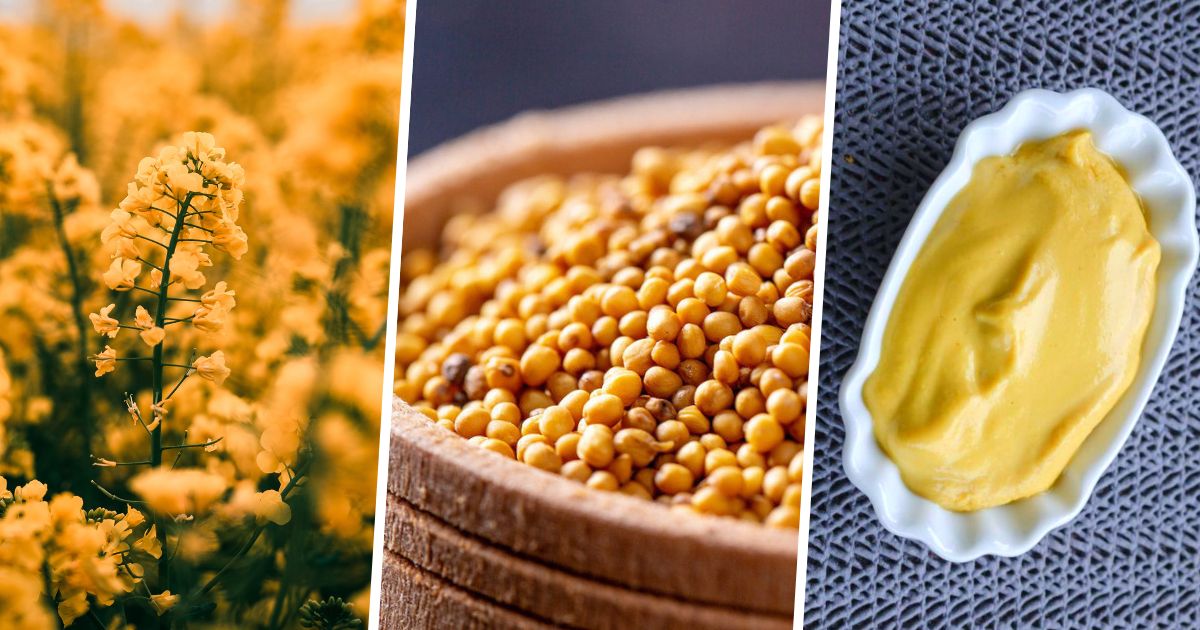Here's what you can expect in our article about American Mustard:
- American Mustard & American Mustard - What Is It Exactly?
- American Mustard: Difference from German Mustard
- Mustard History - Who Invented Mustard and Where?
- Mustard Production: How Mustard Is Made
- 10 Impressive Facts About (American) Mustard
Mustard isn't all the same. Nowadays, there's a variety of different types of mustard. In addition to French Dijon mustard, Bavarian sweet mustard, English mustard, and many other, sometimes regional mustard creations, there's probably the most popular spicy or medium-spicy mustard in Germany - and that's American mustard. In this article, we'll take a closer look at the American Mustard. We'll answer important questions about American mustard, what the differences are, where mustard originates, and how mustard is produced. Finally, we have some facts about mustard that you probably didn't know.
American Mustard & American Mustard - What Is It Exactly?
American mustard, also known as American Mustard here, is not only something special in terms of taste. Characteristic for American mustard is its mild and slightly sweet flavor. It also stands out visually from other types of mustard. Due to the ground mustard seeds and the addition of a higher amount of turmeric, American mustard gets its bright yellow color. This intense yellow hue is also why American mustard is often referred to as Yellow Mustard. However, Americans simply call it mustard. Compared to the medium-spicy mustard we are familiar with, American mustard is less spicy and somewhat milder. The lack of spiciness is compensated by American Mustard's unique aroma and pleasant taste. Of course, the mustard is a perfect match for hot dogs and burgers, as is tradition in America. But it also gives meat and fish a unique flavor. Even sauces, dressings, and dips can be enhanced with American Mustard.
In addition to traditional American Mustard, there are also some gourmet companies in the USA that have reinterpreted American mustard and created their own unique mustard creations, with Stonewall Kitchen specialty manufacturer from Maine leading the way. We've sampled through their various creations and imported a diverse selection of the tastiest mustard varieties for you:
- Spicy Honey Mustard (spicy mustard refined with exquisite honey)
- Sweet Honey Mustard (intensely sweet honey mustard)
- Caramelized Onion Mustard (fine mustard with caramelized onions)
- Blue Cheese Herb Mustard (flavorful herb mustard with tasty blue cheese)
- Raspberry Honey Mustard Dipping Sauce (French Dijon mustard with fruity raspberries)
Tip: If you don't want to miss the typical mustard flavor even when grilling or having a BBQ, then be sure to try the KC Gold Mustard BBQ Sauce by Rufus Teague from the BBQ hub of Kansas City. The reason for the exceptionally high quality and excellent taste of the American mustard sauce lies in its production. Only the best and completely natural ingredients are used there. In addition, the ingredients are cooked significantly longer, intensifying the flavor.
Speaking of barbecue... Did you know that the barbecue tradition in South Carolina, which involves using spicy mustard sauces (instead of the traditional vinegar and tomato-based sauces), can be traced back to German immigrants? Between 1730 and 1750, many Germans settled in the western part of the U.S. state, where they preferred to operate small farms instead of large plantations, just as they knew from home. Additionally, German immigrants brought their foods and culinary traditions to the United States. The most significant import was mustard, which significantly influenced and continues to shape the barbecue tradition in South Carolina to this day.
American Mustard: Difference from German Mustard
We've already mentioned some differences between American mustard and German mustard. Let's summarize the key differences for you. While German table mustard is typically medium-spicy, American Mustard is known for its milder taste with slightly sweet notes. That's also why American mustard - compared to medium-spicy mustard - can be served with a greater variety of dishes. In American cuisine, it is rightly considered a true all-rounder and is an indispensable staple in many households.
Tip: If you still find the popular German table mustard too spicy, then be sure to try American mustard as an alternative.
There are also slight differences in color between the two mustard varieties. American mustard has a vibrant, almost bright yellow hue. German mustard, on the other hand, is slightly darker. The characteristic color of the well-known German table mustard is a darker, rich yellow hue with shades of brown.
Mustard History - Who Invented Mustard and Where Was Mustard Invented?
If you seek an answer to the question of who invented mustard or where mustard was invented, you need to look back several millennia into the past. The history of mustard begins around 1,000 years before Christ, about 3,000 years ago. The first evidence of the existence of mustard can be found in ancient China. However, mustard was also used as a remedy in historical Egypt. Through the Roman campaigns, mustard seeds made their way to Asia and Europe. Initially, it was mostly used as medicine in these regions. The Greek physician Pedanios Dioskurides described the healing properties of mustard in the first century AD. Around the same time, the Romans discovered the strong spiciness of mustard and adopted the knowledge from the Greeks, using mustard as a remedy as well. About 300 years later, the first recorded mustard recipe was created, consisting of crushed mustard seeds, olive oil, vinegar, and honey.
Mustard's triumph began when it found its way to Central Europe via the Alps. At the end of the eighth century, Charlemagne, the King of the Franks, officially ordered the cultivation of mustard in Germany. In the 14th century, French dukes laid the foundation for the rise of the now-famous Dijon mustard by establishing the first strict quality standards for mustard.
To this day, mustard is considered one of the most widely cultivated and used spices - worldwide.
Mustard Production: How Mustard is Made
For the production of mustard, one needs one crucial thing in addition to the ingredients: time. Although many production steps have been modernized today, mustard production still takes some time. This also applies to the production of American mustard. In the first step of mustard production, the essential ingredient, mustard seeds, is needed. Mustard seeds (also called mustard grains) are found inside the pods of the mustard plant. Each pod contains approximately ten mustard seeds. Once the pods are ripe, the required mustard seeds are extracted from the pods. In the vast majority of cases, this step in mustard production is carried out by the producer, the one who grows the mustard plants.
After the mustard seeds have been separated from the pods, they must undergo a thorough cleaning process in a complex procedure. Before the cleaned mustard seeds can be further processed, they are typically stored in tanks for several weeks. In the subsequent stages of mustard production, the stored mustard seeds are crushed, defatted, and ground into very fine mustard flour (or mustard meal). This process breaks open the individual seeds, exposing essential oils. After the mustard seeds have been ground into a powdery texture, the essential basic ingredients such as water, salt, vinegar, and other spices are added. This mixture is then stirred in the mash tank until the so-called "mash" is formed. By grinding the mustard seeds in the previous step, the surface of each individual mustard seed is increased, allowing the individual seeds to swell more quickly in the mash tank.
In the next stage of mustard production, the paste-like mash is finely ground once again in a gentle process. Some mustard manufacturers repeat this process one or more times. To prevent the mustard from getting too hot, it is cooled down using a heat exchanger. Through the grinding of the mash, the liquid ingredients (water and vinegar) form a permanent bond with the spices and mustard meal, resulting in the familiar creamy consistency of mustard. However, mustard production is not yet complete. Before the mustard can be filled and sold, it is vented in large tanks and aged for a period ranging from 1 to 14 days, allowing it to fully develop its flavor.
As mentioned earlier, the frequency of grinding the mash varies from producer to producer. There are also differences in the types of mustard seeds used. For spicier mustard varieties, more dark mustard seeds, namely black and brown mustard seeds, are used in production. If the mustard is intended to be somewhat milder, the proportion of white mustard seeds is significantly higher. In general, it can be said: the darker the mustard seed appears, the spicier and more flavorful the mustard will be in production.
10 Impressive Facts About (American) Mustard
- In the USA, the National Mustard Day is celebrated on the first Saturday in August.
- According to Pythagoras, mustard is believed to sharpen not only your appetite but also your mind.
- In Wisconsin, USA, there is a dedicated Mustard Museum with over 6,000 varieties of mustard.
- Mustard does not spoil; it may lose some spiciness and flavor after its best-before date.
- Mustard is among the most popular and most commonly used spices worldwide.
- Mustard belongs to the brassica family and is thus related to broccoli.
- The word "mustard" has a Latin origin.
- Mustard is one of the 14 allergens in the EU that must be specially labeled as an ingredient in food products.
- In Germany, the average per capita consumption of mustard in 2021 was approximately 850 grams.
- All parts of the mustard plant are edible, including the leaves, seeds, and flowers.





